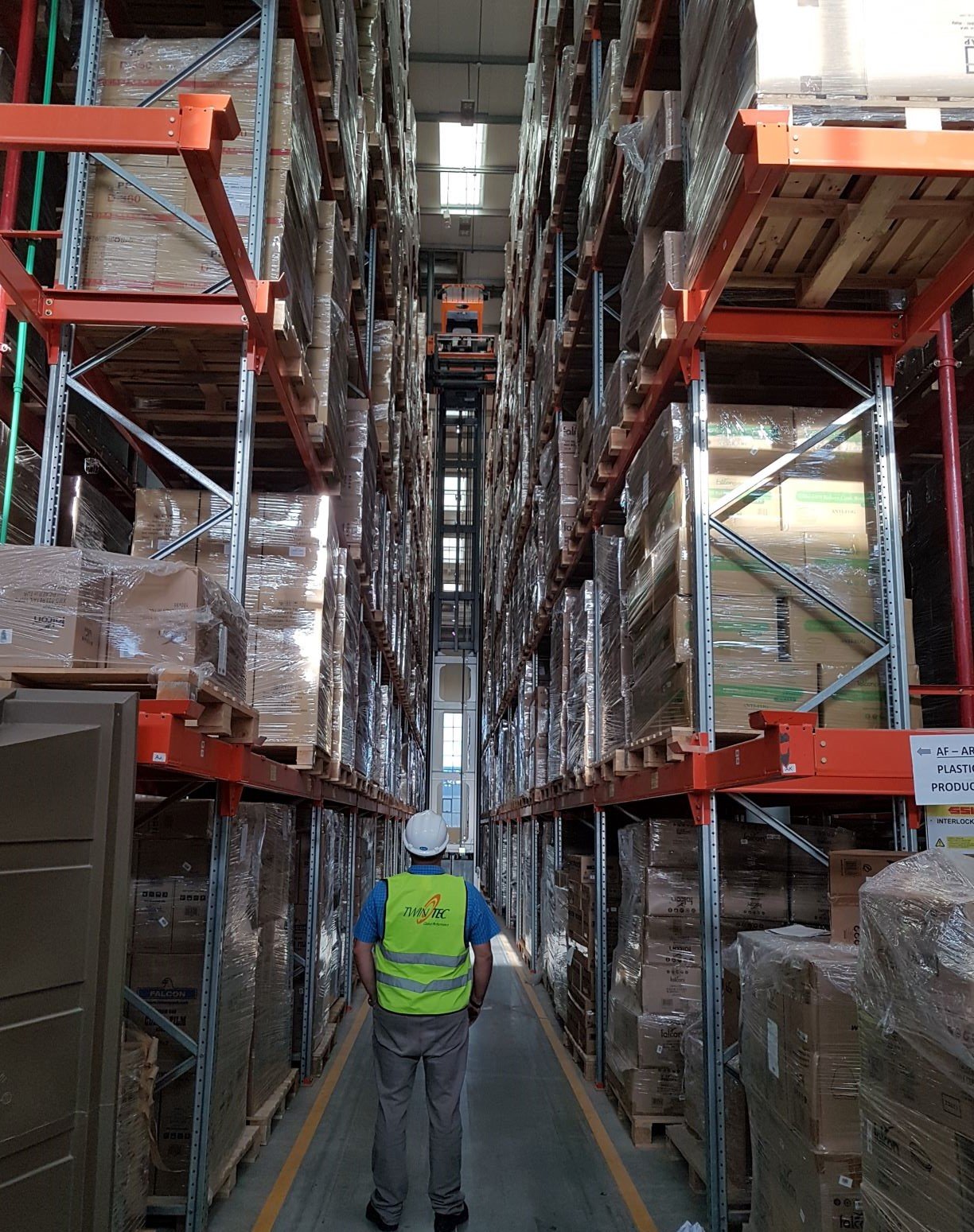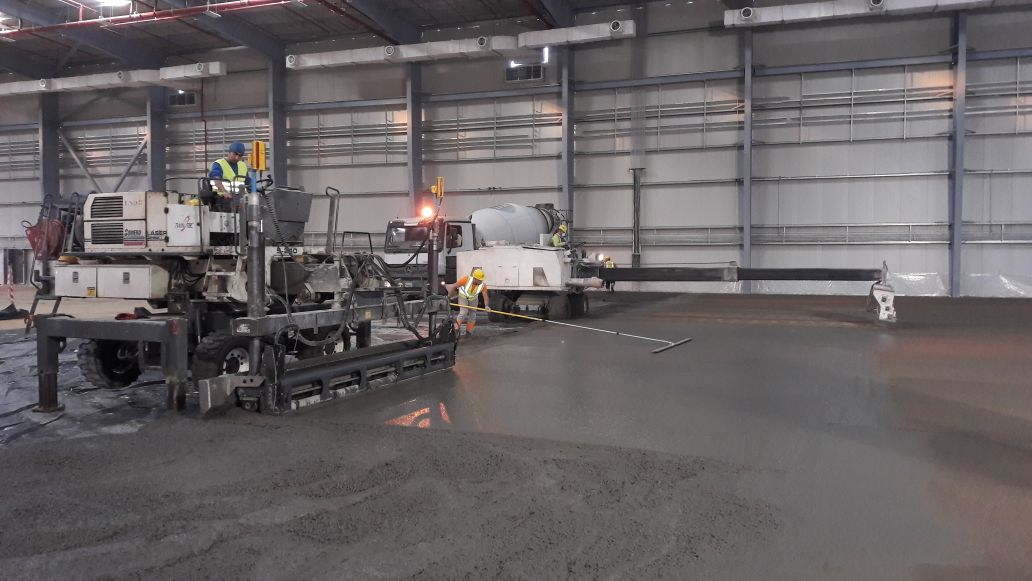VNA warehouse flooring: the major elements for success
Published on 29 October 2019

VNA Floor in Operation
In the modern global logistics environment, Very Narrow Aisle (VNA) storage solutions are becoming more common. Critical to the safe and successful operation of a VNA system is the warehouse concrete floor slab.
Below is an introduction to understanding the major elements required for a successful and safe VNA floor.
1. SPECIFICATION
Many different international specifications for level and flatness exist and are based on the different types of usage that floors are subject to. TR34, DIN, ACI, Eurocode and others exist. Specifications range from basic general usage to very precise levels tolerance, performance requirements and suggest range of flatness and levels specifications based on the varying requirements of the specified use. These standards have similar requirements for different specified uses and whilst some "overlap" each other, they should not be intermingled or combined.
Parameters Defining VNA Tolerance Specification
Where the optimised storage solution for a facility is to be very narrow aisle (VNA), an associated VNA flatness tolerance should be specified for the floor. This needs to be in accordance with the width and height of the storage aisles as well as the exact geometry of the MHE (materials handling equipment) to be used. Under-specification of tolerance is likely to result in inefficient or unsafe operation of the MHE, whilst over specification is an inefficient investment of the client's funds and is unlikely to enhance performance.
Choosing the Right Specification
The intended operation of the facility is the starting point for correct flatness tolerance specification of any VNA floor. Consider:
- Maximum height of operation (top beam of racking)
- Width of aisles (pallet to pallet)
- Intended speed at maximum operating height of MHE
- MHE axle width and spacing
Higher operating heights and speeds will increase the required flatness specification. The minimum void between the goods being moved and the face of stored pallets will also have a bearing.
As new, more efficient storage and handling methods continue to evolve, it is noticeable that storage heights continue to extend. Where 13m high storage was once considered extremely high, systems now operate in excess of 20m. Traditionally standards had simply defined the highest VNA heights as 13m+ and were designed accordingly though modern operations of almost twice the height, clearly have much more onerous requirements of the floor flatness.
The required floor slab tolerance specification should increase according to the maximum height of operation, therefore specifications working in consideration of +/- 13m are logically not relevant to 20m operation. In this regard, international surveyors and specialists working with the International Forklift Manufacturer's Association, have produced a floor level tolerance specification relating to higher VNA operation. Certainly, above 14m VNA operation, the VDMA specification should be considered. Contact Twintec for further information. VDMA flatness specification is designed to become more onerous, pro-rata to the operating height of MHE. It should be noted that these very high tolerance specifications come with associated concrete floor slab design and installation costs.
2. DURABILITY
MHE in VNA operation is automatically guided, either by rigid guide rails fixed to the floor in front of the rack bases or by an inductance wire, embedded in the floor. This fixes the exact travel path of the MHE and therefore the precise repeated travel path of the MHE wheels. The same wheel path will be used every time the MHE moves in the aisles. This high repetitive trafficking of exactly the same points of the floor will quickly expose any weakness in surface or detail durability.
Even with the highest abrasion resistant concrete, after some period of operation of the MHE, the concrete becomes more polished under the repetitive operation. For well produced abrasion resistant concrete surfaces, this is not an issue but any weaker locations such as local surface damages and joints, rapid and costly deterioration can occur to the MHE as well as the floor.
In this respect, the reduction or removal of floor joints is a major benefit in the reduction of floor and MHE maintenance, as well as increasing the efficiency and safety of facility operation.
Consider a Twintec Twinplan or Twintec Ultimate floor slab for exceptional durability and performance.
3. CONSTRUCTION
There are many elements required in production of the building envelope, utilities, and fit-out. In all cases except the floor and foundations, the specified elements are factory manufactured products, delivered, assembled and connected at site.
The floor, one of the most expensive and important elements, is effectively manufactured at site. The time available for satisfactory construction of the floor is of course limited by the inevitable rate of setting of concrete so the selection of a specialist concrete flooring contractor with an experienced skilled workforce and a track record of designing, constructing and guaranteeing floors to the highest quality and flatness specifications is essential.
For the uninitiated, the occurrence of unforeseen difficulties is unforgiving and has a direct impact on the finished product. You wouldn't want a general surgeon to carry out brain surgery - why choose a general contractor for your floor slab when you can select a specialist concrete flooring contractor? Remediation works post floor slab construction to meet the required flatness standard for safe operation of the VNA system can be slow and is extremely expensive.
 The client/end-user are those who will either suffer or benefit from the quality of the installed floor. In this respect they should seek the best performing designs with minimised associated durability issues by selecting a performance warrantied product, designed, supplied and installed by a reputable specialist contractor.
The client/end-user are those who will either suffer or benefit from the quality of the installed floor. In this respect they should seek the best performing designs with minimised associated durability issues by selecting a performance warrantied product, designed, supplied and installed by a reputable specialist contractor.
4. MEASUREMENT
Floor slab tolerance achievement is measured against data collected from the finished floor, specifically in the MHE wheel paths. The volume of data to be collected and reviewed requires robotic tools to be reliable. Self propelled survey robots travel in the precisely located wheel paths to collect this data which is subsequently downloaded to analytic equipment for review and summary according to the specified flatness tolerance.
For very high tolerances, some allowance for local remedial grinding should be considered. To create ultra-durable floors with limited or no joints in very large areas, some grinding (<5% in wheel tracks) may be required for full flatness specification compliance. Demands for 100% compliance without grinding could be achieved by strip method installation but the associated weak joints will soon require costly maintenance and efficiency of operation can be lost impacting on business performance metrics.
The definition of a well achieved flatness tolerance should always be the satisfactory operation of the specified MHE.
Design and Quality Controlled Installation
Notwithstanding any of the above important items, higher storage will usually mean higher loads on your floor. Whilst considering durability in design, ensure that the selected design and construction method are compatible with the required result and tolerance. Ensure that good planning and QC are adhered to throughout the process and that proper liability for design and installation are understood and accepted by the relevant parties. Spilt responsibility in design and installation can be a "minefield" for building owners should issues arise in the performance of their floor.
Summary
VNA floors are specialist both in use and production. Aim for the most durable designs well associated with the required usage and installed and warrantied by specialists.
For general international business enquiries, email our international business team at r.waugh@twintecgroup.com
Click here to follow us on LinkedIn.
Topics: Twintec Ultimate, Warehouse, SFRC, VNA


Comments
If you liked this article please share it or add a comment below